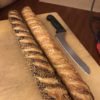A plot of land in Seattle has been transformed into The Beacon Food Forest – a permaculture design experiment come to life. Think of a typical community garden where volunteers grow food, but on a large, self-perpetuating scale that includes varietals of trees and plants not normally available in grocery stores at all, let alone in the underprivileged neighborhood where the forest is planted. The (literal) fruits of the gardeners labors are free to the public, giving access to fresh produce – and the experience of harvesting it – to those who might not otherwise have it.

Rico Gagliano: What exactly is a food forest?
Jenny Pell: We’re talking about trees and vines and all kinds of perennial plants. Rather than having a patch of cukes and tomatoes and carrots, where you have to replant every year, a food forest is going to mature over time into a really abundant fruit and berry and vegetable system. And what we’re looking at is mimicking the forest ecosystem — the natural ecosystem.
Glenn Herlihy: So it’s basically a delicious, healthy forest.
Rico Gagliano: Where did the idea come from to do that with the land instead of you know, your standard park?
Glenn Herlihy: It came out of a permaculture design class. The final design project was to design a farm for a piece of land, and myself and a few others saw this piece of land in my neighborhood, and thought we’d do a dream design for it for the class, but we ended up taking it to the community and actually produce a physical project.
Rico Gagliano: Now, here’s the part of this I think is most spectacular to people. As you mentioned, this is a community project. This is in a multi-ethnic, lower-income community. It’s a great resource for them. It’s open to the public. Anyone can come in and take this food.
But there’s the rub. What if one person or a few people come in and just help themselves to a large portion of the food? What do you do?
Glenn Herlihy: Yeah, that doesn’t seem to be a problem in our city here; we have a lot of public gardens. Where it does seem to be a problem is small gardens that have one or two trees, and maybe they’ll see their harvest get diminished in the night.
With the Beacon Food Forest we have this large tract of land to create a real abundance, and it won’t be possible to steal everything. And you can’t call it stealing, because we’re giving it away.And frankly, if there’s no damage done to the tree and the land, then we consider ourselves successful.
Jenny Pell: Yeah, if they eat it all, then we’re stoked. What that really means if they eat it all is that we need more food forests.
Rico Gagliano: But what about commercial interest? What about somebody coming in and taking food and profiting from it?
Jenny Pell: No one’s asked that question of me before. Mostly people say, “What if homeless people eat it?” I say, “Great! Homeless people need fresh food.” But I think that in terms of the commercial interest, I’ve never had anybody say what if somebody comes and harvests it all and sells it.
Rico Gagliano: I’m glad to bring that to your attention. What would happen if it did, though? I mean, there are plenty of small farm-to-table restaurants that would love to have a nearby, extremely local source of really fresh blueberries or whatever.

Glenn Herlihy: Yeah, but if they got caught doing it man, that would be bad press for them. We’ve got a lot of eyes on the garden. There’s a lot of community involvement, and that puts people there most of the day and into the evening, and we hold a lot of events, and we’re very visible in our location, so that all deters people coming in and stealing, so to speak.
Rico Gagliano: This has been going for about a year now. What is actually available now? What kind of stuff is growing there at the moment?
Glenn Herlihy: We have a lot of pumpkins going right now. We plan on doing a lot of carving and eating of those. We’ve had a lot of kale and broccoli and just some annuals, but our trees are young, and we had a few plums and apples and pears, but it will be a few years before we see a significant amount of harvest.
Actually, we had one quince going this year.
We salvaged this probably 5- or 7-year-old tree, and we weren’t sure it was gonna make it. But it produced a quince, and we were psyched, and it sat there on top of the tree for all summer long into the fall. It was just about there, and I think it had just reached ripeness, and it disappeared.And that was actually a joyous moment, that someone could find a use for it, and it wasn’t lying on the ground, so they obviously took it home and you know, made jam with one quince.
Rico Gagliano: A tiny, tiny jar of quince jam.
Glenn Herlihy: That’s right.
Rico Gagliano: What else? My understanding is that there’s some odd fruits that you’re planning on.
Glenn Herlihy: There are varieties that we won’t find in our grocery stores. A lot of them are hard to transport or they’re just not grown commercially. We’ll have varieties of plums that you don’t see in grocery stores: Shiro plums and European plums. And there are apple varieties that you don’t seen in a lot of orchards around here.
Jenny Pell: One of my favorites is mulberries. You don’t see mulberries at market because they produce over a really long period of time, but only small amounts. So every day, you can go get a small bowl for breakfast, but you don’t ever get a gigantic harvest.
Rico Gagliano: And that is the dream of any urban farming project, I think: Step outside and there’s just food sitting there that you can put on your cereal.
Jenny Pell: I want kids to have that experience of going into the berry patch and stuffing their face. And really, what low-income family can afford raspberries? It’s $7 for just a tiny container. To be able to go and just eat and eat and eat and eat until you can’t eat anymore — that’s what we want. We want kids to know that there’s abundance and that it’s not expensive. Raspberries are about the easiest thing to propagate in the world.


